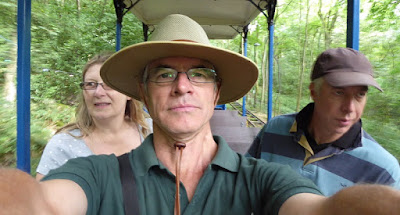Today started well. We were up and almost breakfasted before CRT started measuring up
Jubilee to make sure it would fit in the tunnel. It passed the test, and I realised that I could have left most of the roof furniture in place. I had taken the precaution of putting the gangplank and cabin shafts inside.
One thing it would have been handy to know in advance was that CRT ask you to remove side fenders. Ours tie to small metal loops on the edge of the gunwales - to remove the offside ones I had to push the boat across to the other side.
Back on the right side our CRT chaperone, Josh, introduced himself to us and issued me with a life jacket, hi-vis jacket and hard hat. I chose to wear my own life jacket which passed muster. Jan would be staying inside for the passage.
At 0830 we were ready for the off.
Things proceeded according to plan to start with. There were some tight sections which I navigated through successfully; we waved to the "shadow", the CRT team tracking our progress in the adjacent disused railway tunnel; the rubbing strake lived up to its name once or twice.
The tunnel keeps one on one's toes with narrow but high spray concreted sections, low brick arches, rough-hewn rock and so on. Jan says it was like caving from the comfort of your own home. It was amazing! And much better motoring through rather than our last passage of ten years ago, when the boats were joined together in a train following us boaters in an electric passenger module.
The end of the tunnel came into sight.
And then ... a look of horror on Josh's face as we came across something which was definitely not as it should have been. Several
concrete* timber beams had become dislodged; the ends were hanging down in a decidedly falling down manner. "Stop!" called Josh.
We paused long enough only for Josh to take a couple of photos; I took the opportunity to fire off some as well.
The lowest ends of the beams were about a foot higher than the cabin top and to the right of the centre line. The photo shows that at least seven beams were out of position; hanging on horizontally on the lowest pair were what looked like the remains of a metal girder. The bright spot on the right is the beam from Josh's miner's lamp.
Then Josh said, in a calm voice, "We need to get out of here as fast as possible".
I eased the boat into gear, we crouched down and gently accelerated past the danger zone.
We were all right, but Josh was concerned for the safety of the two following boats. The only way of warning them about the danger was to phone the tunnel office and get the message through to the "shadow" team who could then stop the boats at the rendezvous points.
But with five sixths of the passage completed we had passed the last rendezvous point so for fifteen minutes we three were the only people who knew about the problem. Josh was in full "this is where the training kicks in" mode as he went through the options for the tunnel. At first he thought that the beams were under the live railway line - if they were, then Network Rail would probably have to close the line. This turned out not to be the case; I understand that they were below an access passage between the live rail tunnel and a disused one.
And what should be done about the other boats in the tunnel? They would either creep past and hope nothing falls on them or they would have to be pulled out backwards. Before we reached the exit Josh had pretty much decided the latter was what would have to happen.
As soon as we got out, 1 hour 30 minutes after entering, Josh leapt off and phoned the office. The line was engaged! For what seemed like several long minutes - but was probably only two - Josh couldn't get through. Then contact was made and there was a period when we couldn't do anything but put the kettle on. Josh gladly accepted the offer of coffee; when I gave it to him he said it was very good, but he doesn't usually drink coffee!
At this stage we were asked not to tell anyone what had happened as there were still families on boats in the tunnel and there was no point spreading alarm.
As predicted CRT immediately closed the tunnel and set about sending in a rescue tug to pull out the two boats inside. We felt sad for the people on the boats having to come out the wrong way, as well as for those waiting at Diggle for their turn to go in. It was to these boaters that Josh had to walk to break the bad news that their passage was going to be delayed.
And so we scraped through Standedge Tunnel, the last boat to transit for what might be some time.
The rest of the day would have been newsworthy for a struggle to get to Dobcross owing to low pounds, but you've had enough excitement for one blog post!
*Jan remembers Josh saying they were concrete; I thought he described them as timber
edited to update: they were timber beams









































































